http://scholar.google.com/citations?hl=en&user=95SvbM8AAAAJ
PAS Autreto MJ Lagos, J Bettini
Surface effects on the mechanical elongation of AuCu nanowires: De-alloying and the formation of mixed suspended atomic chains Journal Article
Em: Journal of Applied Physics, vol. 117, não 9, pp. 094301, 2015.
@article{Lagos2015,
title = {Surface effects on the mechanical elongation of AuCu nanowires: De-alloying and the formation of mixed suspended atomic chains},
author = {MJ Lagos, PAS Autreto, J Bettini, F Sato, SO Dantas, DS Galvao, D Ugarte},
url = {http://scitation.aip.org/content/aip/journal/jap/117/9/10.1063/1.4913625},
doi = {10.1063/1.4913625},
year = {2015},
date = {2015-03-07},
journal = {Journal of Applied Physics},
volume = {117},
number = {9},
pages = {094301},
abstract = {We report here an atomistic study of the mechanical deformation of Au x Cu (1− x ) atomic-size wires (nanowires (NWs)) by means of high resolution transmission electron microscopy experiments. Molecular dynamics simulations were also carried out in order to obtain deeper insights on the dynamical properties of stretched NWs. The mechanical properties are significantly dependent on the chemical composition that evolves in time at the junction; some structures exhibit a remarkable de-alloying behavior. Also, our results represent the first experimental realization of mixed linear atomic chains (LACs) among transition and noble metals; in particular, surface energies induce chemical gradients on NW surfaces that can be exploited to control the relative LAC compositions (different number of gold and copper atoms). The implications of these results for nanocatalysis and spin transport of one-atom-thick metal wires are addressed.},
keywords = {},
pubstate = {published},
tppubtype = {article}
}
Autreto, Pedro Alves da Silva; Galvao, Douglas S; Artacho, Emilio
Species Fractionation in Atomic Chains from Mechanically Stretched Alloys Journal Article
Em: arXiv preprint arXiv:1312.1285, 2013.
@article{autreto2013species,
title = {Species Fractionation in Atomic Chains from Mechanically Stretched Alloys},
author = {Autreto, Pedro Alves da Silva and Galvao, Douglas S and Artacho, Emilio},
url = {http://arxiv.org/abs/1312.1285},
year = {2013},
date = {2013-01-01},
journal = {arXiv preprint arXiv:1312.1285},
abstract = {Bettini et al. [Nature Nanotech 1, 182 (2006)] reported the first experimental realization of linear
atomic chains (LACs) composed of different atoms (Au and Ag). Different contents of Au and Ag
were observed in the chains from what found in the bulk alloys, which rises the question of what is the
wire composition if in equilibrium with a bulk alloy. In this work we address the thermodynamic
driving force for species fractionation in LACs under tension, and we present density-functional
theory results for Ag-Au chain alloys. A pronounced stabilization of wires with an alternating
Ag-Au sequence is observed, which could be behind the experimentally observed Au enrichment in
LACs from alloys of high Ag content.},
keywords = {},
pubstate = {published},
tppubtype = {article}
}
atomic chains (LACs) composed of different atoms (Au and Ag). Different contents of Au and Ag
were observed in the chains from what found in the bulk alloys, which rises the question of what is the
wire composition if in equilibrium with a bulk alloy. In this work we address the thermodynamic
driving force for species fractionation in LACs under tension, and we present density-functional
theory results for Ag-Au chain alloys. A pronounced stabilization of wires with an alternating
Ag-Au sequence is observed, which could be behind the experimentally observed Au enrichment in
LACs from alloys of high Ag content.
Lagos, MJ; Autreto, PAS; Galvao, DS; Ugarte, D
Correlation between quantum conductance and atomic arrangement of atomic-size silver nanowires Journal Article
Em: Journal of Applied Physics, vol. 111, não 12, pp. 124316, 2012.
@article{lagos2012correlationb,
title = {Correlation between quantum conductance and atomic arrangement of atomic-size silver nanowires},
author = {Lagos, MJ and Autreto, PAS and Galvao, DS and Ugarte, D},
url = {http://scitation.aip.org/content/aip/journal/jap/111/12/10.1063/1.4729805},
year = {2012},
date = {2012-01-01},
journal = {Journal of Applied Physics},
volume = {111},
number = {12},
pages = {124316},
publisher = {AIP Publishing},
abstract = {We have studied the effect of thermal effects on the structural and transport response of Ag atomic-size nanowires (NWs) generated by mechanical elongation. Our study involves both time-resolved atomic resolution transmission electron microscopy imaging and quantum conductance measurement using an ultra-high-vacuum mechanically controllable break junction. We have observed drastic changes in conductance and structuralproperties of Agnanowires generated at different temperatures (150 and 300 K). By combining electron microscopy images, electronic transport measurements, and quantum transport calculations, we have been able to obtain a consistent correlation between the conductance and structuralproperties of Ag NWs. In particular, our study has revealed the formation of metastable rectangular rod-like Agwire (3/3) along the [001] crystallographic direction, whose formation is enhanced. These results illustrate the high complexity of analyzing structural and quantum conductance behaviour of metal atomic-size wires; also, they reveal that it is extremely difficult to compare NW conductance experiments performed at different temperatures due to the fundamental modifications of the mechanical behavior.
},
keywords = {},
pubstate = {published},
tppubtype = {article}
}
Autreto, Pedro A; Lagos, Maureen J; Ugarte, Daniel; Galvao, Douglas S
Correlation Between Quantum Conductance and Atomic Arrangement of Silver Atomic-Size Nanocontacts Proceedings
Cambridge University Press, vol. 1429, 2012.
@proceedings{autreto2012correlation,
title = {Correlation Between Quantum Conductance and Atomic Arrangement of Silver Atomic-Size Nanocontacts},
author = {Autreto, Pedro A and Lagos, Maureen J and Ugarte, Daniel and Galvao, Douglas S},
url = {http://journals.cambridge.org/action/displayAbstract?fromPage=online&aid=8717061&fileId=S1946427412015011},
year = {2012},
date = {2012-01-01},
journal = {MRS Proceedings},
volume = {1429},
pages = {mrss12--1429},
publisher = {Cambridge University Press},
abstract = {In this work we have studied the importance of thermal effects on the structural and transport properties of Ag atomic-size nanowires (NWs) generated by mechanical stretching. Our study involve time-resolved atomic high resolution transmission electron microscopy imaging and quantum conductance measurement using an ultra-high-vacuum mechanically controllable break junction combined with quantum transport calculations. We have observed drastic changes in conductance and structural properties of Ag NWs generated at different temperatures (150 and 300 K). By combining electron microscopy images, electronic transport measurements and theoretical modeling, we have been able to establish a consistent correlation between the conductance and structural properties of Ag NWs. In particular, our study has revealed the formation of metastable rectangular rod-like Ag wires along the [001] crystallographic direction.},
keywords = {},
pubstate = {published},
tppubtype = {proceedings}
}
Lagos, MJ; Autreto, PAS; Galvao, DS; Ugarte, D
Correlation between Quantum Conductance and Atomic Arrangement of Silver Atomic-Size Nanowires Journal Article
Em: arXiv preprint arXiv:1206.2551, 2012, (Draft version of: Correlation between quantum conductance and atomic arrangement of atomic-size silver nanowires Journal of Applied Physics, 111 (12), pp. 124316, 2012.).
@article{lagos2012correlation,
title = {Correlation between Quantum Conductance and Atomic Arrangement of Silver Atomic-Size Nanowires},
author = {Lagos, MJ and Autreto, PAS and Galvao, DS and Ugarte, D},
url = {http://arxiv.org/abs/1206.2551},
year = {2012},
date = {2012-01-01},
journal = {arXiv preprint arXiv:1206.2551},
abstract = {We have studied the effect of thermal effects on the structural and transport response of Ag atomic-size nanowires generated by mechanical elongation. Our study involves both time-resolved atomic resolution transmission electron microscopy imaging and quantum conductance measurement using an ultra-high-vacuum mechanically controllable break junction. We have observed drastic changes in conductance and structural properties of Ag nanowires generated at different temperatures (150 and 300 K). By combining electron microscopy images, electronic transport measurements and quantum transport calculations, we have been able to obtain a consistent correlation between the conductance and structural properties of Ag NWs. In particular, our study has revealed the formation of metastable rectangular rod-like Ag wire (3/3) along the (001) crystallographic direction, whose formation is enhanced. These results illustrate the high complexity of analyzing structural and quantum conductance behaviour of metal atomic-size wires; also, they reveal that it is extremely difficult to compare NW conductance experiments performed at different temperatures due to the fundamental modifications of the mechanical behavior.},
note = {Draft version of:
Correlation between quantum conductance and atomic arrangement of atomic-size silver nanowires
Journal of Applied Physics, 111 (12), pp. 124316, 2012.},
keywords = {},
pubstate = {published},
tppubtype = {article}
}
PAS Autreto MJ Lagos, SB Legoas
Temperature effects on the occurrence of long interatomic distances in atomic chains formed from stretched gold nanowires Journal Article
Em: Nanotechnology, vol. 22, não 9, pp. 095705, 2011.
@article{Lagos2011,
title = {Temperature effects on the occurrence of long interatomic distances in atomic chains formed from stretched gold nanowires},
author = {MJ Lagos, PAS Autreto, SB Legoas, F Sato, V Rodrigues, DS Galvao, D Ugarte},
url = {http://iopscience.iop.org/0957-4484/22/9/095705},
year = {2011},
date = {2011-03-04},
journal = {Nanotechnology},
volume = {22},
number = {9},
pages = {095705},
abstract = {The origin of long interatomic distances in suspended gold atomic chains formed from stretched nanowires remains the object of debate despite the large amount of theoretical and experimental work. Here, we report new atomic resolution electron microscopy observations acquired at room and liquid-nitrogen temperatures and theoretical results from ab initio quantum molecular dynamics on chain formation and stability. These new data are suggestive that the long distances are due to contamination by carbon atoms originating from the decomposition of adsorbed hydrocarbon molecules.
},
keywords = {},
pubstate = {published},
tppubtype = {article}
}
Autreto, PAS; Lagos, MJ; Sato, F; Bettini, J; Rocha, AR; Rodrigues, V; Ugarte, D; Galvao, DS
Intrinsic Stability of the Smallest Possible Silver Nanotube Journal Article
Em: Physical Review Letters, vol. 106, não 6, pp. 065501, 2011.
@article{autreto2011intrinsic,
title = {Intrinsic Stability of the Smallest Possible Silver Nanotube},
author = {Autreto, PAS and Lagos, MJ and Sato, F and Bettini, J and Rocha, AR and Rodrigues, V and Ugarte, D and Galvao, DS},
url = {http://journals.aps.org/prl/abstract/10.1103/PhysRevLett.106.065501},
year = {2011},
date = {2011-01-01},
journal = {Physical Review Letters},
volume = {106},
number = {6},
pages = {065501},
publisher = {American Physical Society},
abstract = {Recently, Lagos et al. [Nature Nanotech. 4, 149 (2009)] reported the discovery of the smallest possible Ag nanotube with a square cross section. Ab initio density functional theory calculations strongly support that the stability of these hollow structures is structurally intrinsic and not the result of contamination by light atoms. We also report the first experimental observation of the theoretically predicted corrugation of the hollow structure. Quantum conductance calculations predict a unique signature of 3.6G0 for this new family of nanotubes.},
keywords = {},
pubstate = {published},
tppubtype = {article}
}
Lagos, Maureen J; Sato, Fernando; Galvao, Douglas S; Ugarte, Daniel
Mechanical deformation of nanoscale metal rods: when size and shape matter Journal Article
Em: Physical Review Letters, vol. 106, não 5, pp. 055501, 2011.
@article{lagos2011mechanical,
title = {Mechanical deformation of nanoscale metal rods: when size and shape matter},
author = {Lagos, Maureen J and Sato, Fernando and Galvao, Douglas S and Ugarte, Daniel},
url = {http://journals.aps.org/prl/abstract/10.1103/PhysRevLett.106.055501},
year = {2011},
date = {2011-01-01},
journal = {Physical Review Letters},
volume = {106},
number = {5},
pages = {055501},
publisher = {American Physical Society},
abstract = {Face centered cubic metals deform mainly by propagating partial dislocations generating planar fault ribbons. How do metals deform if the size is smaller than the fault ribbons? We studied the elongation of Au and Pt nanorods by in situ electron microscopy and ab initio calculations. Planar fault activation barriers are so low that, for each temperature, a minimal rod size is required to become active for releasing elastic energy. Surface effects dominate deformation energetics; system size and shape determine the preferred fault gliding directions which induce different tensile and compressive behavior.
},
keywords = {},
pubstate = {published},
tppubtype = {article}
}
Lagos, MJ; Autreto, PAS; Legoas, SB; Sato, F; Rodrigues, V; Galvao, DS; Ugarte, D
Temperature effects on the occurrence of long interatomic distances in atomic chains formed from stretched gold nanowires Journal Article
Em: Nanotechnology, vol. 22, não 9, pp. 095705, 2011.
@article{lagos2011temperature,
title = {Temperature effects on the occurrence of long interatomic distances in atomic chains formed from stretched gold nanowires},
author = {Lagos, MJ and Autreto, PAS and Legoas, SB and Sato, F and Rodrigues, V and Galvao, DS and Ugarte, D},
url = {http://iopscience.iop.org/0957-4484/21/48/485702},
year = {2011},
date = {2011-01-01},
journal = {Nanotechnology},
volume = {22},
number = {9},
pages = {095705},
publisher = {IOP Publishing},
abstract = {We have studied the changes induced by thermal effects in the structural and transport response of Au nanowires generated by mechanical elongation. We have used time-resolved atomic resolution transmission electron microscopy imaging and quantum conductance measurement using a mechanically controllable break junction. Our results showed remarkable differences in the NW evolution for experiments realized at 150 and 300 K, which modifies drastically the conductance response during elongation. Molecular dynamics and electronic transport calculations were used to consistently correlate the observed structural and conductance behavior. These results emphasize that it is essential to take into account the precise atomic arrangement of nanocontacts generated by mechanical stretching to understand electrical transport properties. Also, our study shows that much care must be taken when comparing results obtained in different experimental conditions, mainly different temperatures.
},
keywords = {},
pubstate = {published},
tppubtype = {article}
}
Lagos, MJ; Sato, F; Autreto, PAS; Galvao, DS; Rodrigues, V; Ugarte, D
Temperature effects on the atomic arrangement and conductance of atomic-size gold nanowires generated by mechanical stretching Journal Article
Em: Nanotechnology, vol. 21, não 48, pp. 485702, 2010.
@article{lagos2010temperature,
title = {Temperature effects on the atomic arrangement and conductance of atomic-size gold nanowires generated by mechanical stretching},
author = {Lagos, MJ and Sato, F and Autreto, PAS and Galvao, DS and Rodrigues, V and Ugarte, D},
url = {http://iopscience.iop.org/0957-4484/21/48/485702},
year = {2010},
date = {2010-01-01},
journal = {Nanotechnology},
volume = {21},
number = {48},
pages = {485702},
publisher = {IOP Publishing},
abstract = {We have studied the changes induced by thermal effects in the structural and transport response of Au nanowires generated by mechanical elongation. We have used time-resolved atomic resolution transmission electron microscopy imaging and quantum conductance measurement using a mechanically controllable break junction. Our results showed remarkable differences in the NW evolution for experiments realized at 150 and 300 K, which modifies drastically the conductance response during elongation. Molecular dynamics and electronic transport calculations were used to consistently correlate the observed structural and conductance behavior. These results emphasize that it is essential to take into account the precise atomic arrangement of nanocontacts generated by mechanical stretching to understand electrical transport properties. Also, our study shows that much care must be taken when comparing results obtained in different experimental conditions, mainly different temperatures.
},
keywords = {},
pubstate = {published},
tppubtype = {article}
}
Lagos, MJ; Sato, Fernando; Bettini, Jeferson; Rodrigues, Varlei; Galvao, Douglas S; Ugarte, Daniel
Observation of the smallest metal nanotube with a square cross-section Journal Article
Em: Nature Nanotechnology, vol. 4, não 3, pp. 149–152, 2009.
@article{lagos2009observation,
title = {Observation of the smallest metal nanotube with a square cross-section},
author = {Lagos, MJ and Sato, Fernando and Bettini, Jeferson and Rodrigues, Varlei and Galvao, Douglas S and Ugarte, Daniel},
url = {http://www.nature.com/nnano/journal/v4/n3/abs/nnano.2008.414.html},
year = {2009},
date = {2009-01-01},
journal = {Nature Nanotechnology},
volume = {4},
number = {3},
pages = {149--152},
publisher = {Nature Publishing Group},
abstract = {Understanding the mechanical properties of nanoscale systems requires a range of measurement techniques and theoretical approaches to gather the relevant physical and chemical information. The arrangements of atoms in nanostructures and macroscopic matter can be different, principally due to the role of surface energy, but the interplay between atomic and electronic structure in association with applied mechanical stress can also lead to surprising differences. For example, metastable structures such as suspended chains of atoms1, 2, 3 and helical wires4, 5 have been produced by stretching metal junctions. Here, we report the spontaneous formation of the smallest possible metal nanotube with a square cross-section during the elongation of silver nanocontacts. Ab initio calculations and molecular simulations indicate that the hollow wire forms because this configuration allows the surface energy to be minimized, and also generates a soft structure capable of absorbing a huge tensile deformation.},
keywords = {},
pubstate = {published},
tppubtype = {article}
}
Sato, Fernando; Lagos, Maureen; Autreto, Pedro; Ugarte, Daniel; Galvao, Douglas
On the Lifetime of Suspended Atomic Chains Formed from Stretched Metallic Gold Nanowires Journal Article
Em: Physicae, vol. 8, não 8, 2009, (Invited Paper).
@article{sato2009lifetime,
title = {On the Lifetime of Suspended Atomic Chains Formed from Stretched Metallic Gold Nanowires},
author = {Sato, Fernando and Lagos, Maureen and Autreto, Pedro and Ugarte, Daniel and Galvao, Douglas},
url = {http://physicae.ifi.unicamp.br/physicae/article/viewArticle/109},
year = {2009},
date = {2009-01-01},
journal = {Physicae},
volume = {8},
number = {8},
abstract = {Metallic nanowires have been object of intense theoretical and experimental works in the lastyears. In spite of the large number of studies for such systems some fundamental aspects remain open and polemical questions. In this work we report preliminary results for the study of the final steps of Au suspended atomic chains (LACs) with different number of atoms as a function of tem-perature. We have carried out classical molecular dynamics simulations using tight-binding models with a second moment approximations. Our results suggest a more complex phenomenon than previously anticipated. The dynamics of chain rupture seems to be determined beyond thermodynamics contributions and the bond breaking patterns were observed to be chain-length dependent.
},
note = {Invited Paper},
keywords = {},
pubstate = {published},
tppubtype = {article}
}
Lagos, M; Sato, F; Bettini, J; Rdrigues, V; Galvao, D; Ugarte, D
Atomic-size Silver Nanotube Book Section
Em: EMC 2008 14th European Microscopy Congress 1--5 September 2008, Aachen, Germany, pp. 493–494, Springer Berlin Heidelberg, 2008, (Book Chapter).
@incollection{lagos2008atomic,
title = {Atomic-size Silver Nanotube},
author = {Lagos, M and Sato, F and Bettini, J and Rdrigues, V and Galvao, D and Ugarte, D},
url = {http://link.springer.com/chapter/10.1007%2F978-3-540-85156-1_247},
year = {2008},
date = {2008-01-01},
booktitle = {EMC 2008 14th European Microscopy Congress 1--5 September 2008, Aachen, Germany},
pages = {493--494},
publisher = {Springer Berlin Heidelberg},
abstract = {The atomic arrangement of nanosystems may be quite different from the traditional materials; surface energy minimization plays a dominant role in this size range, and accounts for many of these new structures. Graphitic nanotubes [1] represent the best example, being fromed by a rolled the graphitic layer, which is tradionally flat. Subsequently the rolling of the compact (111) atomic planes was reported for gold nanowires (NW) generated by mechanical stretching [2]. But, we may expect many more surprises from the interplay between atomic and electronic structure.},
note = {Book Chapter},
keywords = {},
pubstate = {published},
tppubtype = {incollection}
}
Rodrigues, Varlei; Sato, Fernando; Galvao, Douglas S; Ugarte, Daniel
Is Small Perfect? Size Limit to Defect Formation in Pyramidal Pt Nanocontacts Journal Article
Em: arXiv preprint arXiv:0707.4187, 2007.
@article{rodrigues2007small,
title = {Is Small Perfect? Size Limit to Defect Formation in Pyramidal Pt Nanocontacts},
author = {Rodrigues, Varlei and Sato, Fernando and Galvao, Douglas S and Ugarte, Daniel},
url = {http://xxx.tau.ac.il/abs/0707.4187},
year = {2007},
date = {2007-01-01},
journal = {arXiv preprint arXiv:0707.4187},
abstract = {We report high resolution transmission electron microscopy and ab initio calculation results for the defect formation in Pt nanocontacts (NCs). Our results show that there is a size limit to the existence of twins (extended structural defects). Defects are always present but blocked away from the tip axes. The twins may act as scattering plane, influencing contact electron transmission for Pt NC at room temperature and Ag/Au NC at low temperature.},
keywords = {},
pubstate = {published},
tppubtype = {article}
}
Rodrigues, V; Sato, F; Galvao, DS; Ugarte, D
Size limit of defect formation in pyramidal Pt nanocontacts Journal Article
Em: Physical Review Letters, vol. 99, não 25, pp. 255501, 2007.
@article{rodrigues2007size,
title = {Size limit of defect formation in pyramidal Pt nanocontacts},
author = {Rodrigues, V and Sato, F and Galvao, DS and Ugarte, D},
url = {http://journals.aps.org/prl/abstract/10.1103/PhysRevLett.99.255501},
year = {2007},
date = {2007-01-01},
journal = {Physical Review Letters},
volume = {99},
number = {25},
pages = {255501},
publisher = {American Physical Society},
abstract = {We report high resolution transmission electron microscopy and ab initio calculation results for defect formation in sharp pyramidal Pt nanocontacts. Our results show that there is a size limit to the existence of twins (extended structural defects). These defects are always present but blocked away from the tip axes. They may act as scattering planes, influencing the electron conductance for Pt nanocontacts at room temperature and Ag/Au nanocontacts at low temperature (<150 K).},
keywords = {},
pubstate = {published},
tppubtype = {article}
}
da Fonseca, Alexandre Fontes; Malta, CP; Galvao, Douglas S
Elastic Properties of Normal and Binormal Helical Nanowires Proceedings
Cambridge University Press, vol. 963, 2006.
@proceedings{da2006elasticb,
title = {Elastic Properties of Normal and Binormal Helical Nanowires},
author = {da Fonseca, Alexandre Fontes and Malta, CP and Galvao, Douglas S},
url = {http://journals.cambridge.org/action/displayAbstract?fromPage=online&aid=8026852},
year = {2006},
date = {2006-01-01},
journal = {MRS Proceedings},
volume = {963},
pages = {0963--Q20},
publisher = {Cambridge University Press},
abstract = {A helical nanowire can be defined as being a nanoscopic rod whose axis follows a helical curve in space. In the case of a nanowire with asymmetric cross section, the helical nanostructure can be classified as normal or binormal helix, according to the orientation of the cross section with respect to the helical axis of the structure. In this work, we present a simple model to study the elastic properties of a helical nanowire with asymmetric cross section. We use the framework of the Kirchhoff rod model to obtain an expression relating the Hooke's constant, h, of normal and binormal nanohelices to their geometric features. We also obtain the Young's modulus values. These relations can be used by experimentalists to evaluate the elastic properties of helical nanostructures. We showed that the Hooke's constant of a normal nanohelix is higher than that of a binormal one. We illustrate our results using experimentally obtained nanohelices reported in the literature.},
keywords = {},
pubstate = {published},
tppubtype = {proceedings}
}
Bettini, Jefferson; Sato, Fernando; Coura, Pablo Zimmerman; Dantas, SO; Galvao, Douglas Soares; Ugarte, Daniel
Experimental realization of suspended atomic chains composed of different atomic species Journal Article
Em: Nature Nanotechnology, vol. 1, não 3, pp. 182–185, 2006.
@article{bettini2006experimental,
title = {Experimental realization of suspended atomic chains composed of different atomic species},
author = {Bettini, Jefferson and Sato, Fernando and Coura, Pablo Zimmerman and Dantas, SO and Galvao, Douglas Soares and Ugarte, Daniel},
url = {http://www.nature.com/nnano/journal/v1/n3/full/nnano.2006.132.html},
year = {2006},
date = {2006-01-01},
journal = {Nature Nanotechnology},
volume = {1},
number = {3},
pages = {182--185},
publisher = {Nature Publishing Group},
abstract = {Research into nanostructured materials frequently relates to pure substances. This contrasts with industrial applications, where chemical doping or alloying is often used to enhance the electrical or mechanical properties of materials1. However, the controlled preparation of doped nanomaterials has been much more difficult than expected because the increased surface-area-to-volume ratio can, for instance, lead to the expulsion of impurities (self-purification)2. For nanostructured alloys, the influence of growth methods and the atomic structure on self-purification is still open to investigation2, 3. Here, we explore, experimentally and with molecular dynamics simulations, to what extent alloying persists in the limit that a binary metal is mechanically stretched to a linear chain of atoms. Our results reveal a gradual evolution of the arrangement of the different atomic elements in the narrowest region of the chain, where impurities may be expelled to the surface or enclosed during elongation.
},
keywords = {},
pubstate = {published},
tppubtype = {article}
}
Sato, F; Moreira, AS; Bettini, J; Coura, PZ; Dantas, SO; Ugarte, D; Galvao, DS
On the Formation of Copper Linear Atomic Suspended Chains Journal Article
Em: arXiv preprint cond-mat/0602092, 2006.
@article{sato2006formation,
title = {On the Formation of Copper Linear Atomic Suspended Chains},
author = {Sato, F and Moreira, AS and Bettini, J and Coura, PZ and Dantas, SO and Ugarte, D and Galvao, DS},
url = {http://arxiv.org/abs/cond-mat/0602092},
year = {2006},
date = {2006-01-01},
journal = {arXiv preprint cond-mat/0602092},
abstract = {We report high resolution transmission electron microscopy and classical molecular dynamics simulation results of mechanically stretching copper nanowires conducting to linear atomic suspended chains (LACs) formation. In contrast with some previous experimental and theoretical work in literature that stated that the formation of LACs for copper should not exist our results showed the existence of LAC for the [111], [110], and [100] crystallographic directions, being thus the sequence of most probable occurence.},
keywords = {},
pubstate = {published},
tppubtype = {article}
}
Sato, F; Moreira, AS; Bettini, J; Coura, PZ; Dantas, SO; Ugarte, D; Galvao, DS
Transmission electron microscopy and molecular dynamics study of the formation of suspended copper linear atomic chains Journal Article
Em: Physical Review-Section B-Condensed Matter, vol. 74, não 19, pp. 193401–193401, 2006.
@article{sato2006surface,
title = {Transmission electron microscopy and molecular dynamics study of the formation of suspended copper linear atomic chains},
author = {Sato, F and Moreira, AS and Bettini, J and Coura, PZ and Dantas, SO and Ugarte, D and Galvao, DS},
url = {http://journals.aps.org/prb/abstract/10.1103/PhysRevB.74.193401},
year = {2006},
date = {2006-01-01},
journal = {Physical Review-Section B-Condensed Matter},
volume = {74},
number = {19},
pages = {193401--193401},
publisher = {Woodbury, NY: published by the American Physical Society through the American Institute of Physics, c1998-},
abstract = {We report high-resolution transmission electron microscopy and molecular dynamics simulation results of mechanically stretching nanowires leading to linear atomic suspended chain (LAC) formation. In contrast with some previous experimental and theoretical works in the literature that stated that the formation of LAC’s for copper should be unlikely our results showed the existence of LAC’s for the [111], [110], and [100] crystallographic directions, being thus the sequence of most probable occurrence. Our results clearly indicate that temperture and pulling velocity, associated with internal stress, are fundamental aspects to determine LAC formation.},
keywords = {},
pubstate = {published},
tppubtype = {article}
}
Sato, F; Moreira, AS; Coura, PZ; Dantas, SO; Legoas, SB; Ugarte, D; Galvao, DS
Computer simulations of gold nanowire formation: the role of outlayer atoms Journal Article
Em: Applied Physics A (invited paper), vol. 81, não 8, pp. 1527–1531, 2005.
@article{sato2005computer,
title = {Computer simulations of gold nanowire formation: the role of outlayer atoms},
author = {Sato, F and Moreira, AS and Coura, PZ and Dantas, SO and Legoas, SB and Ugarte, D and Galvao, DS},
url = {http://link.springer.com/article/10.1007/s00339-005-3390-2},
year = {2005},
date = {2005-01-01},
journal = {Applied Physics A (invited paper)},
volume = {81},
number = {8},
pages = {1527--1531},
publisher = {Springer-Verlag},
abstract = {Metallic nanowires (NWs) have been the object of intense theoretical and experimental investigations in the last years. In this work we present and review a new methodology we developed to study NW formation from mechanical stretching. This methodology is based on tight-binding molecular dynamics techniques using second-moment approximations. This methodology had been proven to be very effective in the study of NWs, reliably reproducing the main experimentally observed structural features. We have also investigated the problem of determining from what regions the atoms composing the linear atomic chains come. Our results show that ∼90% of these atoms come from outmost external layers.
},
keywords = {},
pubstate = {published},
tppubtype = {article}
}
2015
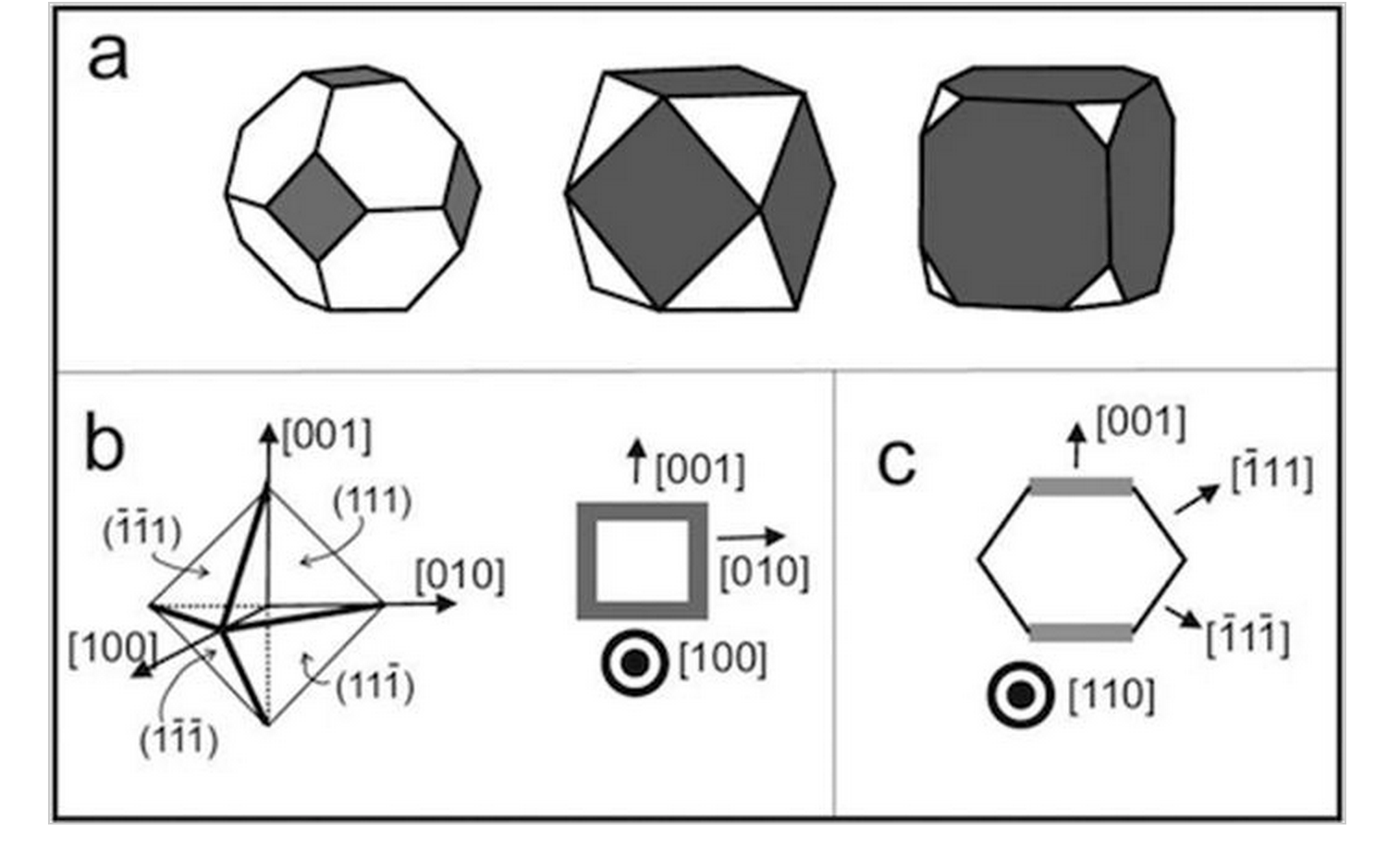
PAS Autreto MJ Lagos, J Bettini
Surface effects on the mechanical elongation of AuCu nanowires: De-alloying and the formation of mixed suspended atomic chains Journal Article
Em: Journal of Applied Physics, vol. 117, não 9, pp. 094301, 2015.
Resumo | Links | BibTeX | Tags: Metallic Nanowires, Molecular Dynamics, TEM, Theory of Electronic Indices
@article{Lagos2015,
title = {Surface effects on the mechanical elongation of AuCu nanowires: De-alloying and the formation of mixed suspended atomic chains},
author = {MJ Lagos, PAS Autreto, J Bettini, F Sato, SO Dantas, DS Galvao, D Ugarte},
url = {http://scitation.aip.org/content/aip/journal/jap/117/9/10.1063/1.4913625},
doi = {10.1063/1.4913625},
year = {2015},
date = {2015-03-07},
journal = {Journal of Applied Physics},
volume = {117},
number = {9},
pages = {094301},
abstract = {We report here an atomistic study of the mechanical deformation of Au x Cu (1− x ) atomic-size wires (nanowires (NWs)) by means of high resolution transmission electron microscopy experiments. Molecular dynamics simulations were also carried out in order to obtain deeper insights on the dynamical properties of stretched NWs. The mechanical properties are significantly dependent on the chemical composition that evolves in time at the junction; some structures exhibit a remarkable de-alloying behavior. Also, our results represent the first experimental realization of mixed linear atomic chains (LACs) among transition and noble metals; in particular, surface energies induce chemical gradients on NW surfaces that can be exploited to control the relative LAC compositions (different number of gold and copper atoms). The implications of these results for nanocatalysis and spin transport of one-atom-thick metal wires are addressed.},
keywords = {Metallic Nanowires, Molecular Dynamics, TEM, Theory of Electronic Indices},
pubstate = {published},
tppubtype = {article}
}
2013
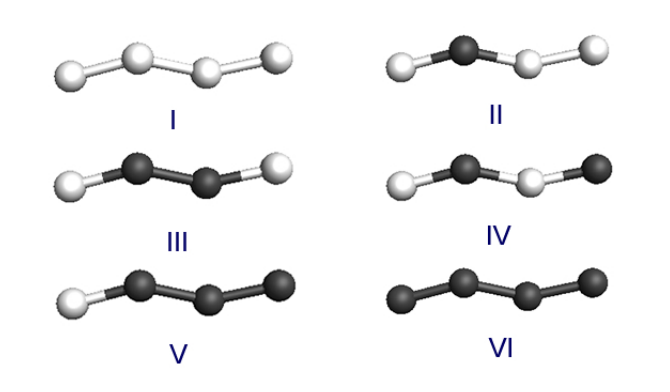
Autreto, Pedro Alves da Silva; Galvao, Douglas S; Artacho, Emilio
Species Fractionation in Atomic Chains from Mechanically Stretched Alloys Journal Article
Em: arXiv preprint arXiv:1312.1285, 2013.
Resumo | Links | BibTeX | Tags: Atomic Chains, DFT, Mech, Mechanical Properties, Metallic Nanowires
@article{autreto2013species,
title = {Species Fractionation in Atomic Chains from Mechanically Stretched Alloys},
author = {Autreto, Pedro Alves da Silva and Galvao, Douglas S and Artacho, Emilio},
url = {http://arxiv.org/abs/1312.1285},
year = {2013},
date = {2013-01-01},
journal = {arXiv preprint arXiv:1312.1285},
abstract = {Bettini et al. [Nature Nanotech 1, 182 (2006)] reported the first experimental realization of linear
atomic chains (LACs) composed of different atoms (Au and Ag). Different contents of Au and Ag
were observed in the chains from what found in the bulk alloys, which rises the question of what is the
wire composition if in equilibrium with a bulk alloy. In this work we address the thermodynamic
driving force for species fractionation in LACs under tension, and we present density-functional
theory results for Ag-Au chain alloys. A pronounced stabilization of wires with an alternating
Ag-Au sequence is observed, which could be behind the experimentally observed Au enrichment in
LACs from alloys of high Ag content.},
keywords = {Atomic Chains, DFT, Mech, Mechanical Properties, Metallic Nanowires},
pubstate = {published},
tppubtype = {article}
}
atomic chains (LACs) composed of different atoms (Au and Ag). Different contents of Au and Ag
were observed in the chains from what found in the bulk alloys, which rises the question of what is the
wire composition if in equilibrium with a bulk alloy. In this work we address the thermodynamic
driving force for species fractionation in LACs under tension, and we present density-functional
theory results for Ag-Au chain alloys. A pronounced stabilization of wires with an alternating
Ag-Au sequence is observed, which could be behind the experimentally observed Au enrichment in
LACs from alloys of high Ag content.
2012
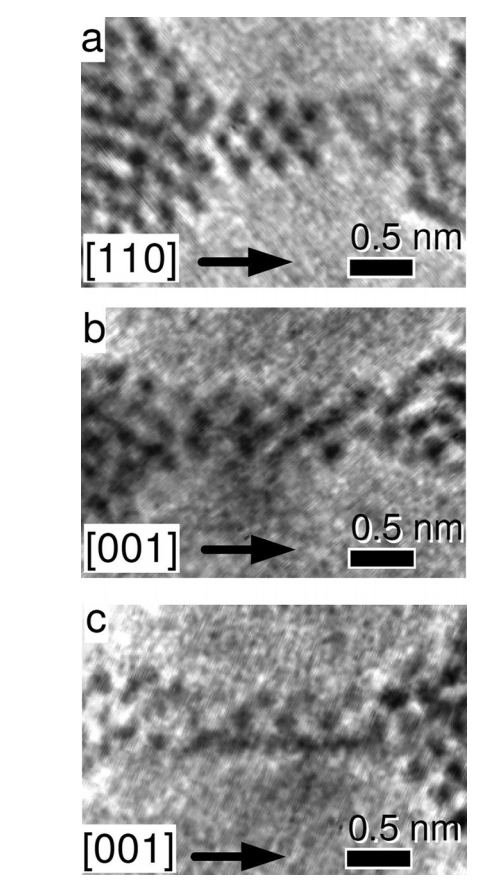
Lagos, MJ; Autreto, PAS; Galvao, DS; Ugarte, D
Correlation between quantum conductance and atomic arrangement of atomic-size silver nanowires Journal Article
Em: Journal of Applied Physics, vol. 111, não 12, pp. 124316, 2012.
Resumo | Links | BibTeX | Tags: Metallic Nanowires, Quantum Transport, TEM
@article{lagos2012correlationb,
title = {Correlation between quantum conductance and atomic arrangement of atomic-size silver nanowires},
author = {Lagos, MJ and Autreto, PAS and Galvao, DS and Ugarte, D},
url = {http://scitation.aip.org/content/aip/journal/jap/111/12/10.1063/1.4729805},
year = {2012},
date = {2012-01-01},
journal = {Journal of Applied Physics},
volume = {111},
number = {12},
pages = {124316},
publisher = {AIP Publishing},
abstract = {We have studied the effect of thermal effects on the structural and transport response of Ag atomic-size nanowires (NWs) generated by mechanical elongation. Our study involves both time-resolved atomic resolution transmission electron microscopy imaging and quantum conductance measurement using an ultra-high-vacuum mechanically controllable break junction. We have observed drastic changes in conductance and structuralproperties of Agnanowires generated at different temperatures (150 and 300 K). By combining electron microscopy images, electronic transport measurements, and quantum transport calculations, we have been able to obtain a consistent correlation between the conductance and structuralproperties of Ag NWs. In particular, our study has revealed the formation of metastable rectangular rod-like Agwire (3/3) along the [001] crystallographic direction, whose formation is enhanced. These results illustrate the high complexity of analyzing structural and quantum conductance behaviour of metal atomic-size wires; also, they reveal that it is extremely difficult to compare NW conductance experiments performed at different temperatures due to the fundamental modifications of the mechanical behavior.
},
keywords = {Metallic Nanowires, Quantum Transport, TEM},
pubstate = {published},
tppubtype = {article}
}
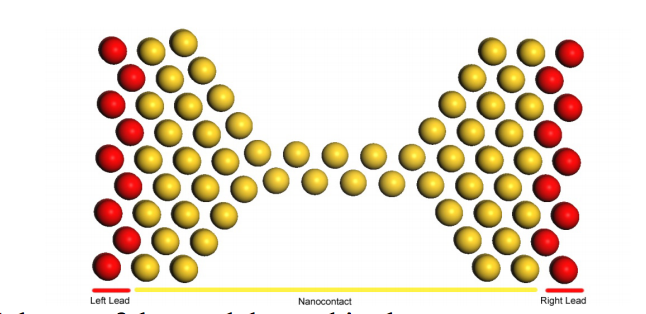
Autreto, Pedro A; Lagos, Maureen J; Ugarte, Daniel; Galvao, Douglas S
Correlation Between Quantum Conductance and Atomic Arrangement of Silver Atomic-Size Nanocontacts Proceedings
Cambridge University Press, vol. 1429, 2012.
Resumo | Links | BibTeX | Tags: Metallic Nanowires, Quantum Transport, TEM
@proceedings{autreto2012correlation,
title = {Correlation Between Quantum Conductance and Atomic Arrangement of Silver Atomic-Size Nanocontacts},
author = {Autreto, Pedro A and Lagos, Maureen J and Ugarte, Daniel and Galvao, Douglas S},
url = {http://journals.cambridge.org/action/displayAbstract?fromPage=online&aid=8717061&fileId=S1946427412015011},
year = {2012},
date = {2012-01-01},
journal = {MRS Proceedings},
volume = {1429},
pages = {mrss12--1429},
publisher = {Cambridge University Press},
abstract = {In this work we have studied the importance of thermal effects on the structural and transport properties of Ag atomic-size nanowires (NWs) generated by mechanical stretching. Our study involve time-resolved atomic high resolution transmission electron microscopy imaging and quantum conductance measurement using an ultra-high-vacuum mechanically controllable break junction combined with quantum transport calculations. We have observed drastic changes in conductance and structural properties of Ag NWs generated at different temperatures (150 and 300 K). By combining electron microscopy images, electronic transport measurements and theoretical modeling, we have been able to establish a consistent correlation between the conductance and structural properties of Ag NWs. In particular, our study has revealed the formation of metastable rectangular rod-like Ag wires along the [001] crystallographic direction.},
keywords = {Metallic Nanowires, Quantum Transport, TEM},
pubstate = {published},
tppubtype = {proceedings}
}

Lagos, MJ; Autreto, PAS; Galvao, DS; Ugarte, D
Correlation between Quantum Conductance and Atomic Arrangement of Silver Atomic-Size Nanowires Journal Article
Em: arXiv preprint arXiv:1206.2551, 2012, (Draft version of: Correlation between quantum conductance and atomic arrangement of atomic-size silver nanowires Journal of Applied Physics, 111 (12), pp. 124316, 2012.).
Resumo | Links | BibTeX | Tags: Metallic Nanowires, Quantum Transport, TEM
@article{lagos2012correlation,
title = {Correlation between Quantum Conductance and Atomic Arrangement of Silver Atomic-Size Nanowires},
author = {Lagos, MJ and Autreto, PAS and Galvao, DS and Ugarte, D},
url = {http://arxiv.org/abs/1206.2551},
year = {2012},
date = {2012-01-01},
journal = {arXiv preprint arXiv:1206.2551},
abstract = {We have studied the effect of thermal effects on the structural and transport response of Ag atomic-size nanowires generated by mechanical elongation. Our study involves both time-resolved atomic resolution transmission electron microscopy imaging and quantum conductance measurement using an ultra-high-vacuum mechanically controllable break junction. We have observed drastic changes in conductance and structural properties of Ag nanowires generated at different temperatures (150 and 300 K). By combining electron microscopy images, electronic transport measurements and quantum transport calculations, we have been able to obtain a consistent correlation between the conductance and structural properties of Ag NWs. In particular, our study has revealed the formation of metastable rectangular rod-like Ag wire (3/3) along the (001) crystallographic direction, whose formation is enhanced. These results illustrate the high complexity of analyzing structural and quantum conductance behaviour of metal atomic-size wires; also, they reveal that it is extremely difficult to compare NW conductance experiments performed at different temperatures due to the fundamental modifications of the mechanical behavior.},
note = {Draft version of:
Correlation between quantum conductance and atomic arrangement of atomic-size silver nanowires
Journal of Applied Physics, 111 (12), pp. 124316, 2012.},
keywords = {Metallic Nanowires, Quantum Transport, TEM},
pubstate = {published},
tppubtype = {article}
}
2011
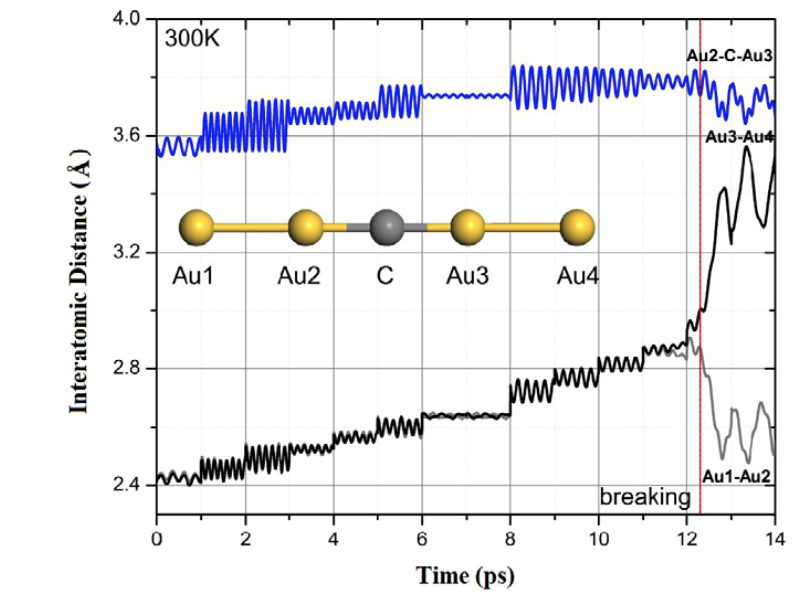
PAS Autreto MJ Lagos, SB Legoas
Temperature effects on the occurrence of long interatomic distances in atomic chains formed from stretched gold nanowires Journal Article
Em: Nanotechnology, vol. 22, não 9, pp. 095705, 2011.
Resumo | Links | BibTeX | Tags: DFT, Gold, Metallic Nanowires, TEM
@article{Lagos2011,
title = {Temperature effects on the occurrence of long interatomic distances in atomic chains formed from stretched gold nanowires},
author = {MJ Lagos, PAS Autreto, SB Legoas, F Sato, V Rodrigues, DS Galvao, D Ugarte},
url = {http://iopscience.iop.org/0957-4484/22/9/095705},
year = {2011},
date = {2011-03-04},
journal = {Nanotechnology},
volume = {22},
number = {9},
pages = {095705},
abstract = {The origin of long interatomic distances in suspended gold atomic chains formed from stretched nanowires remains the object of debate despite the large amount of theoretical and experimental work. Here, we report new atomic resolution electron microscopy observations acquired at room and liquid-nitrogen temperatures and theoretical results from ab initio quantum molecular dynamics on chain formation and stability. These new data are suggestive that the long distances are due to contamination by carbon atoms originating from the decomposition of adsorbed hydrocarbon molecules.
},
keywords = {DFT, Gold, Metallic Nanowires, TEM},
pubstate = {published},
tppubtype = {article}
}

Autreto, PAS; Lagos, MJ; Sato, F; Bettini, J; Rocha, AR; Rodrigues, V; Ugarte, D; Galvao, DS
Intrinsic Stability of the Smallest Possible Silver Nanotube Journal Article
Em: Physical Review Letters, vol. 106, não 6, pp. 065501, 2011.
Resumo | Links | BibTeX | Tags: DFT, Mechanical Properties, Metallic Nanowires, New Structures, top20
@article{autreto2011intrinsic,
title = {Intrinsic Stability of the Smallest Possible Silver Nanotube},
author = {Autreto, PAS and Lagos, MJ and Sato, F and Bettini, J and Rocha, AR and Rodrigues, V and Ugarte, D and Galvao, DS},
url = {http://journals.aps.org/prl/abstract/10.1103/PhysRevLett.106.065501},
year = {2011},
date = {2011-01-01},
journal = {Physical Review Letters},
volume = {106},
number = {6},
pages = {065501},
publisher = {American Physical Society},
abstract = {Recently, Lagos et al. [Nature Nanotech. 4, 149 (2009)] reported the discovery of the smallest possible Ag nanotube with a square cross section. Ab initio density functional theory calculations strongly support that the stability of these hollow structures is structurally intrinsic and not the result of contamination by light atoms. We also report the first experimental observation of the theoretically predicted corrugation of the hollow structure. Quantum conductance calculations predict a unique signature of 3.6G0 for this new family of nanotubes.},
keywords = {DFT, Mechanical Properties, Metallic Nanowires, New Structures, top20},
pubstate = {published},
tppubtype = {article}
}

Lagos, Maureen J; Sato, Fernando; Galvao, Douglas S; Ugarte, Daniel
Mechanical deformation of nanoscale metal rods: when size and shape matter Journal Article
Em: Physical Review Letters, vol. 106, não 5, pp. 055501, 2011.
Resumo | Links | BibTeX | Tags: Defects, DFT, Mechanical Properties, Metallic Nanowires
@article{lagos2011mechanical,
title = {Mechanical deformation of nanoscale metal rods: when size and shape matter},
author = {Lagos, Maureen J and Sato, Fernando and Galvao, Douglas S and Ugarte, Daniel},
url = {http://journals.aps.org/prl/abstract/10.1103/PhysRevLett.106.055501},
year = {2011},
date = {2011-01-01},
journal = {Physical Review Letters},
volume = {106},
number = {5},
pages = {055501},
publisher = {American Physical Society},
abstract = {Face centered cubic metals deform mainly by propagating partial dislocations generating planar fault ribbons. How do metals deform if the size is smaller than the fault ribbons? We studied the elongation of Au and Pt nanorods by in situ electron microscopy and ab initio calculations. Planar fault activation barriers are so low that, for each temperature, a minimal rod size is required to become active for releasing elastic energy. Surface effects dominate deformation energetics; system size and shape determine the preferred fault gliding directions which induce different tensile and compressive behavior.
},
keywords = {Defects, DFT, Mechanical Properties, Metallic Nanowires},
pubstate = {published},
tppubtype = {article}
}
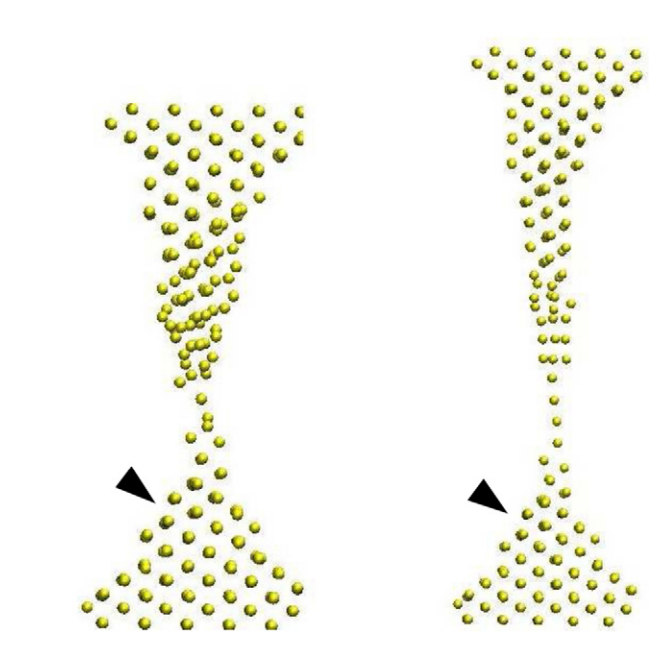
Lagos, MJ; Autreto, PAS; Legoas, SB; Sato, F; Rodrigues, V; Galvao, DS; Ugarte, D
Temperature effects on the occurrence of long interatomic distances in atomic chains formed from stretched gold nanowires Journal Article
Em: Nanotechnology, vol. 22, não 9, pp. 095705, 2011.
Resumo | Links | BibTeX | Tags: Gold, Mechanical Properties, Metallic Nanowires
@article{lagos2011temperature,
title = {Temperature effects on the occurrence of long interatomic distances in atomic chains formed from stretched gold nanowires},
author = {Lagos, MJ and Autreto, PAS and Legoas, SB and Sato, F and Rodrigues, V and Galvao, DS and Ugarte, D},
url = {http://iopscience.iop.org/0957-4484/21/48/485702},
year = {2011},
date = {2011-01-01},
journal = {Nanotechnology},
volume = {22},
number = {9},
pages = {095705},
publisher = {IOP Publishing},
abstract = {We have studied the changes induced by thermal effects in the structural and transport response of Au nanowires generated by mechanical elongation. We have used time-resolved atomic resolution transmission electron microscopy imaging and quantum conductance measurement using a mechanically controllable break junction. Our results showed remarkable differences in the NW evolution for experiments realized at 150 and 300 K, which modifies drastically the conductance response during elongation. Molecular dynamics and electronic transport calculations were used to consistently correlate the observed structural and conductance behavior. These results emphasize that it is essential to take into account the precise atomic arrangement of nanocontacts generated by mechanical stretching to understand electrical transport properties. Also, our study shows that much care must be taken when comparing results obtained in different experimental conditions, mainly different temperatures.
},
keywords = {Gold, Mechanical Properties, Metallic Nanowires},
pubstate = {published},
tppubtype = {article}
}
2010

Lagos, MJ; Sato, F; Autreto, PAS; Galvao, DS; Rodrigues, V; Ugarte, D
Temperature effects on the atomic arrangement and conductance of atomic-size gold nanowires generated by mechanical stretching Journal Article
Em: Nanotechnology, vol. 21, não 48, pp. 485702, 2010.
Resumo | Links | BibTeX | Tags: DFT, Mechanical Properties, Metallic Nanowires, Quantum Transport, TEM
@article{lagos2010temperature,
title = {Temperature effects on the atomic arrangement and conductance of atomic-size gold nanowires generated by mechanical stretching},
author = {Lagos, MJ and Sato, F and Autreto, PAS and Galvao, DS and Rodrigues, V and Ugarte, D},
url = {http://iopscience.iop.org/0957-4484/21/48/485702},
year = {2010},
date = {2010-01-01},
journal = {Nanotechnology},
volume = {21},
number = {48},
pages = {485702},
publisher = {IOP Publishing},
abstract = {We have studied the changes induced by thermal effects in the structural and transport response of Au nanowires generated by mechanical elongation. We have used time-resolved atomic resolution transmission electron microscopy imaging and quantum conductance measurement using a mechanically controllable break junction. Our results showed remarkable differences in the NW evolution for experiments realized at 150 and 300 K, which modifies drastically the conductance response during elongation. Molecular dynamics and electronic transport calculations were used to consistently correlate the observed structural and conductance behavior. These results emphasize that it is essential to take into account the precise atomic arrangement of nanocontacts generated by mechanical stretching to understand electrical transport properties. Also, our study shows that much care must be taken when comparing results obtained in different experimental conditions, mainly different temperatures.
},
keywords = {DFT, Mechanical Properties, Metallic Nanowires, Quantum Transport, TEM},
pubstate = {published},
tppubtype = {article}
}
2009
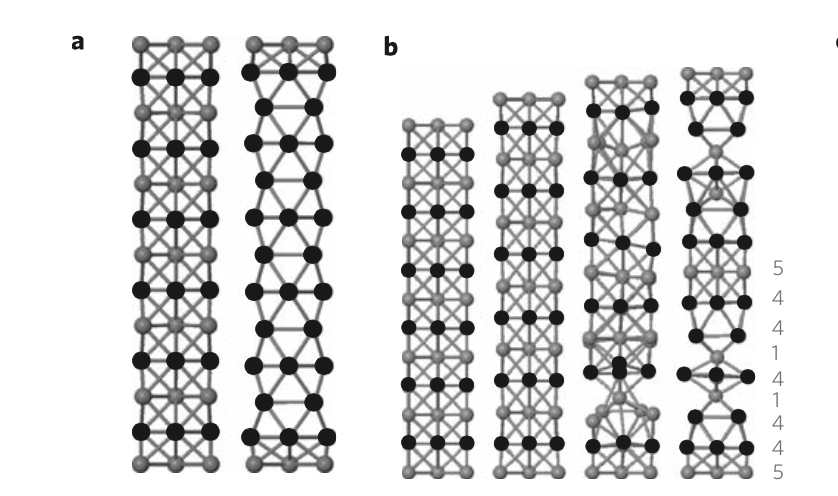
Lagos, MJ; Sato, Fernando; Bettini, Jeferson; Rodrigues, Varlei; Galvao, Douglas S; Ugarte, Daniel
Observation of the smallest metal nanotube with a square cross-section Journal Article
Em: Nature Nanotechnology, vol. 4, não 3, pp. 149–152, 2009.
Resumo | Links | BibTeX | Tags: Metallic Nanowires, New Structures, Smallest nanotube, TEM, top20
@article{lagos2009observation,
title = {Observation of the smallest metal nanotube with a square cross-section},
author = {Lagos, MJ and Sato, Fernando and Bettini, Jeferson and Rodrigues, Varlei and Galvao, Douglas S and Ugarte, Daniel},
url = {http://www.nature.com/nnano/journal/v4/n3/abs/nnano.2008.414.html},
year = {2009},
date = {2009-01-01},
journal = {Nature Nanotechnology},
volume = {4},
number = {3},
pages = {149--152},
publisher = {Nature Publishing Group},
abstract = {Understanding the mechanical properties of nanoscale systems requires a range of measurement techniques and theoretical approaches to gather the relevant physical and chemical information. The arrangements of atoms in nanostructures and macroscopic matter can be different, principally due to the role of surface energy, but the interplay between atomic and electronic structure in association with applied mechanical stress can also lead to surprising differences. For example, metastable structures such as suspended chains of atoms1, 2, 3 and helical wires4, 5 have been produced by stretching metal junctions. Here, we report the spontaneous formation of the smallest possible metal nanotube with a square cross-section during the elongation of silver nanocontacts. Ab initio calculations and molecular simulations indicate that the hollow wire forms because this configuration allows the surface energy to be minimized, and also generates a soft structure capable of absorbing a huge tensile deformation.},
keywords = {Metallic Nanowires, New Structures, Smallest nanotube, TEM, top20},
pubstate = {published},
tppubtype = {article}
}
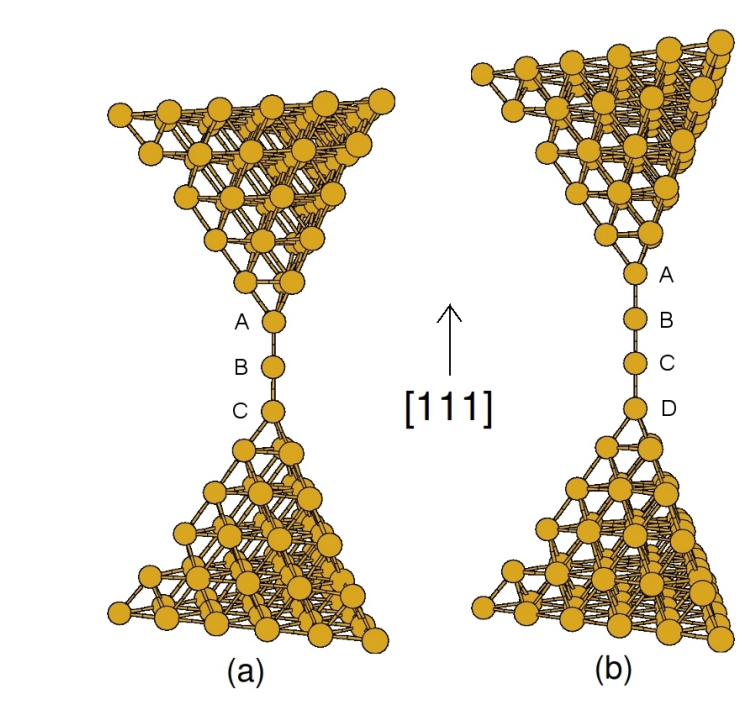
Sato, Fernando; Lagos, Maureen; Autreto, Pedro; Ugarte, Daniel; Galvao, Douglas
On the Lifetime of Suspended Atomic Chains Formed from Stretched Metallic Gold Nanowires Journal Article
Em: Physicae, vol. 8, não 8, 2009, (Invited Paper).
Resumo | Links | BibTeX | Tags: Atomic Chains, Gold, Metallic Nanowires, TEM
@article{sato2009lifetime,
title = {On the Lifetime of Suspended Atomic Chains Formed from Stretched Metallic Gold Nanowires},
author = {Sato, Fernando and Lagos, Maureen and Autreto, Pedro and Ugarte, Daniel and Galvao, Douglas},
url = {http://physicae.ifi.unicamp.br/physicae/article/viewArticle/109},
year = {2009},
date = {2009-01-01},
journal = {Physicae},
volume = {8},
number = {8},
abstract = {Metallic nanowires have been object of intense theoretical and experimental works in the lastyears. In spite of the large number of studies for such systems some fundamental aspects remain open and polemical questions. In this work we report preliminary results for the study of the final steps of Au suspended atomic chains (LACs) with different number of atoms as a function of tem-perature. We have carried out classical molecular dynamics simulations using tight-binding models with a second moment approximations. Our results suggest a more complex phenomenon than previously anticipated. The dynamics of chain rupture seems to be determined beyond thermodynamics contributions and the bond breaking patterns were observed to be chain-length dependent.
},
note = {Invited Paper},
keywords = {Atomic Chains, Gold, Metallic Nanowires, TEM},
pubstate = {published},
tppubtype = {article}
}
2008
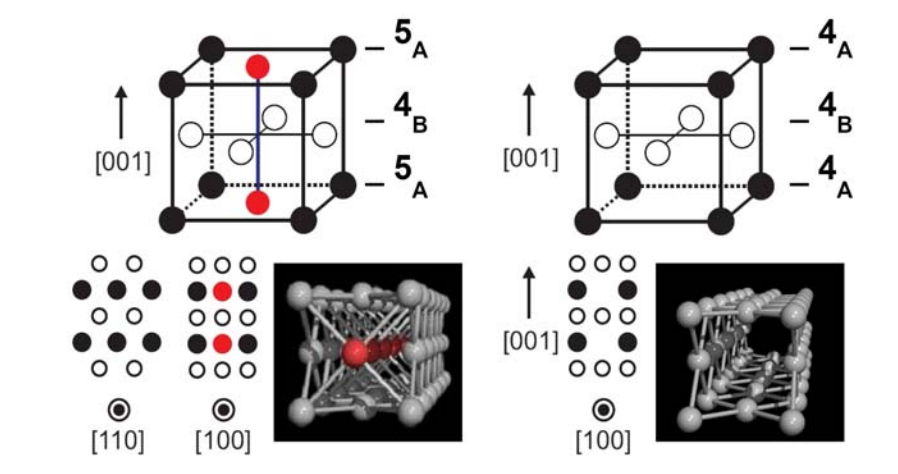
Lagos, M; Sato, F; Bettini, J; Rdrigues, V; Galvao, D; Ugarte, D
Atomic-size Silver Nanotube Book Section
Em: EMC 2008 14th European Microscopy Congress 1--5 September 2008, Aachen, Germany, pp. 493–494, Springer Berlin Heidelberg, 2008, (Book Chapter).
Resumo | Links | BibTeX | Tags: Metallic Nanowires, New Structures, Silver Nanotubes, TEM
@incollection{lagos2008atomic,
title = {Atomic-size Silver Nanotube},
author = {Lagos, M and Sato, F and Bettini, J and Rdrigues, V and Galvao, D and Ugarte, D},
url = {http://link.springer.com/chapter/10.1007%2F978-3-540-85156-1_247},
year = {2008},
date = {2008-01-01},
booktitle = {EMC 2008 14th European Microscopy Congress 1--5 September 2008, Aachen, Germany},
pages = {493--494},
publisher = {Springer Berlin Heidelberg},
abstract = {The atomic arrangement of nanosystems may be quite different from the traditional materials; surface energy minimization plays a dominant role in this size range, and accounts for many of these new structures. Graphitic nanotubes [1] represent the best example, being fromed by a rolled the graphitic layer, which is tradionally flat. Subsequently the rolling of the compact (111) atomic planes was reported for gold nanowires (NW) generated by mechanical stretching [2]. But, we may expect many more surprises from the interplay between atomic and electronic structure.},
note = {Book Chapter},
keywords = {Metallic Nanowires, New Structures, Silver Nanotubes, TEM},
pubstate = {published},
tppubtype = {incollection}
}
2007
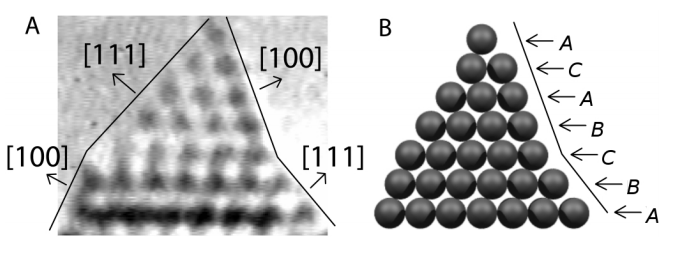
Rodrigues, Varlei; Sato, Fernando; Galvao, Douglas S; Ugarte, Daniel
Is Small Perfect? Size Limit to Defect Formation in Pyramidal Pt Nanocontacts Journal Article
Em: arXiv preprint arXiv:0707.4187, 2007.
Resumo | Links | BibTeX | Tags: Defects, DFT, Metallic Nanowires, Structure, TEM
@article{rodrigues2007small,
title = {Is Small Perfect? Size Limit to Defect Formation in Pyramidal Pt Nanocontacts},
author = {Rodrigues, Varlei and Sato, Fernando and Galvao, Douglas S and Ugarte, Daniel},
url = {http://xxx.tau.ac.il/abs/0707.4187},
year = {2007},
date = {2007-01-01},
journal = {arXiv preprint arXiv:0707.4187},
abstract = {We report high resolution transmission electron microscopy and ab initio calculation results for the defect formation in Pt nanocontacts (NCs). Our results show that there is a size limit to the existence of twins (extended structural defects). Defects are always present but blocked away from the tip axes. The twins may act as scattering plane, influencing contact electron transmission for Pt NC at room temperature and Ag/Au NC at low temperature.},
keywords = {Defects, DFT, Metallic Nanowires, Structure, TEM},
pubstate = {published},
tppubtype = {article}
}
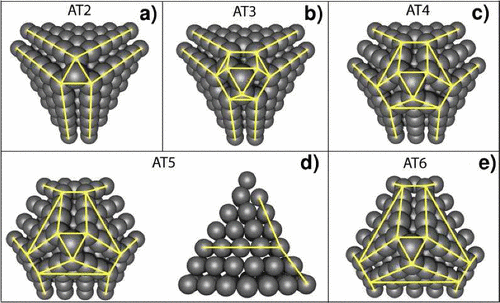
Rodrigues, V; Sato, F; Galvao, DS; Ugarte, D
Size limit of defect formation in pyramidal Pt nanocontacts Journal Article
Em: Physical Review Letters, vol. 99, não 25, pp. 255501, 2007.
Resumo | Links | BibTeX | Tags: DFT, Metallic Nanowires, Platinum, Structure, TEM, top20
@article{rodrigues2007size,
title = {Size limit of defect formation in pyramidal Pt nanocontacts},
author = {Rodrigues, V and Sato, F and Galvao, DS and Ugarte, D},
url = {http://journals.aps.org/prl/abstract/10.1103/PhysRevLett.99.255501},
year = {2007},
date = {2007-01-01},
journal = {Physical Review Letters},
volume = {99},
number = {25},
pages = {255501},
publisher = {American Physical Society},
abstract = {We report high resolution transmission electron microscopy and ab initio calculation results for defect formation in sharp pyramidal Pt nanocontacts. Our results show that there is a size limit to the existence of twins (extended structural defects). These defects are always present but blocked away from the tip axes. They may act as scattering planes, influencing the electron conductance for Pt nanocontacts at room temperature and Ag/Au nanocontacts at low temperature (<150 K).},
keywords = {DFT, Metallic Nanowires, Platinum, Structure, TEM, top20},
pubstate = {published},
tppubtype = {article}
}
2006
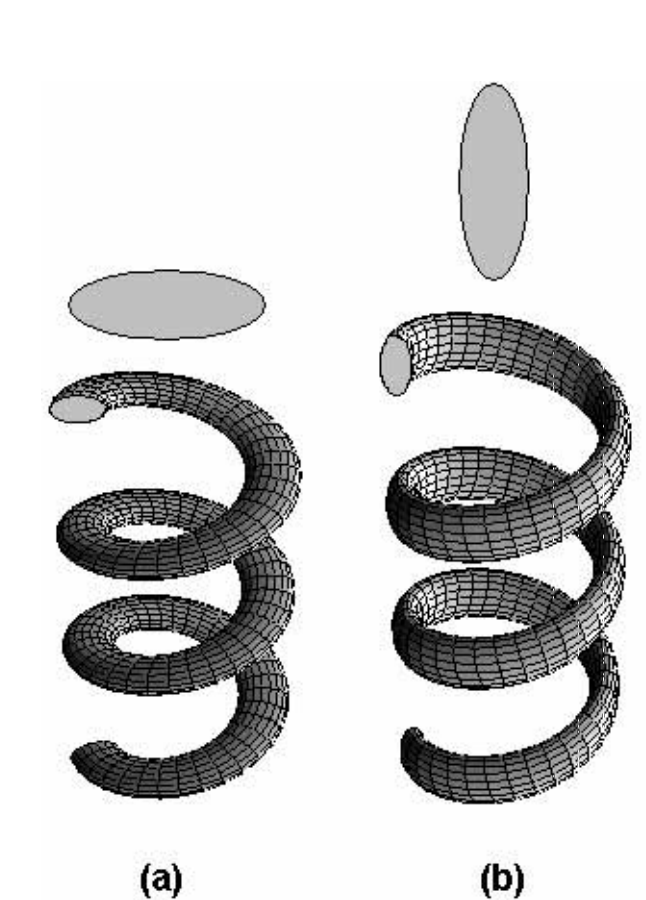
da Fonseca, Alexandre Fontes; Malta, CP; Galvao, Douglas S
Elastic Properties of Normal and Binormal Helical Nanowires Proceedings
Cambridge University Press, vol. 963, 2006.
Resumo | Links | BibTeX | Tags: Elasticity, Filaments, Metallic Nanowires
@proceedings{da2006elasticb,
title = {Elastic Properties of Normal and Binormal Helical Nanowires},
author = {da Fonseca, Alexandre Fontes and Malta, CP and Galvao, Douglas S},
url = {http://journals.cambridge.org/action/displayAbstract?fromPage=online&aid=8026852},
year = {2006},
date = {2006-01-01},
journal = {MRS Proceedings},
volume = {963},
pages = {0963--Q20},
publisher = {Cambridge University Press},
abstract = {A helical nanowire can be defined as being a nanoscopic rod whose axis follows a helical curve in space. In the case of a nanowire with asymmetric cross section, the helical nanostructure can be classified as normal or binormal helix, according to the orientation of the cross section with respect to the helical axis of the structure. In this work, we present a simple model to study the elastic properties of a helical nanowire with asymmetric cross section. We use the framework of the Kirchhoff rod model to obtain an expression relating the Hooke's constant, h, of normal and binormal nanohelices to their geometric features. We also obtain the Young's modulus values. These relations can be used by experimentalists to evaluate the elastic properties of helical nanostructures. We showed that the Hooke's constant of a normal nanohelix is higher than that of a binormal one. We illustrate our results using experimentally obtained nanohelices reported in the literature.},
keywords = {Elasticity, Filaments, Metallic Nanowires},
pubstate = {published},
tppubtype = {proceedings}
}

Bettini, Jefferson; Sato, Fernando; Coura, Pablo Zimmerman; Dantas, SO; Galvao, Douglas Soares; Ugarte, Daniel
Experimental realization of suspended atomic chains composed of different atomic species Journal Article
Em: Nature Nanotechnology, vol. 1, não 3, pp. 182–185, 2006.
Resumo | Links | BibTeX | Tags: Metallic Nanowires, Molecular Dynamics, TEM, top20
@article{bettini2006experimental,
title = {Experimental realization of suspended atomic chains composed of different atomic species},
author = {Bettini, Jefferson and Sato, Fernando and Coura, Pablo Zimmerman and Dantas, SO and Galvao, Douglas Soares and Ugarte, Daniel},
url = {http://www.nature.com/nnano/journal/v1/n3/full/nnano.2006.132.html},
year = {2006},
date = {2006-01-01},
journal = {Nature Nanotechnology},
volume = {1},
number = {3},
pages = {182--185},
publisher = {Nature Publishing Group},
abstract = {Research into nanostructured materials frequently relates to pure substances. This contrasts with industrial applications, where chemical doping or alloying is often used to enhance the electrical or mechanical properties of materials1. However, the controlled preparation of doped nanomaterials has been much more difficult than expected because the increased surface-area-to-volume ratio can, for instance, lead to the expulsion of impurities (self-purification)2. For nanostructured alloys, the influence of growth methods and the atomic structure on self-purification is still open to investigation2, 3. Here, we explore, experimentally and with molecular dynamics simulations, to what extent alloying persists in the limit that a binary metal is mechanically stretched to a linear chain of atoms. Our results reveal a gradual evolution of the arrangement of the different atomic elements in the narrowest region of the chain, where impurities may be expelled to the surface or enclosed during elongation.
},
keywords = {Metallic Nanowires, Molecular Dynamics, TEM, top20},
pubstate = {published},
tppubtype = {article}
}
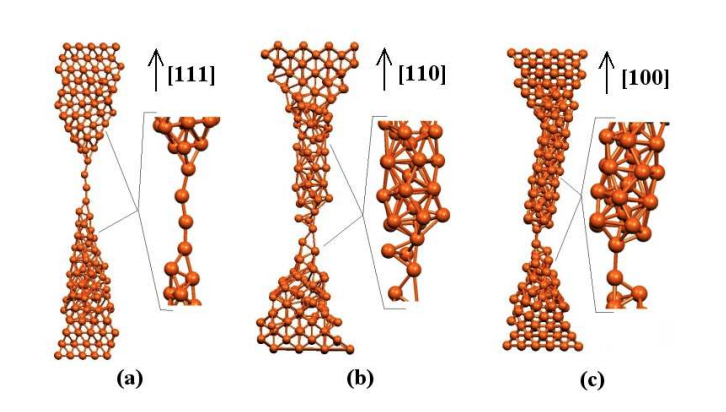
Sato, F; Moreira, AS; Bettini, J; Coura, PZ; Dantas, SO; Ugarte, D; Galvao, DS
On the Formation of Copper Linear Atomic Suspended Chains Journal Article
Em: arXiv preprint cond-mat/0602092, 2006.
Resumo | Links | BibTeX | Tags: Copper, Linear Atomic Chains, Metallic Nanowires, Molecular Dynamics, TEM
@article{sato2006formation,
title = {On the Formation of Copper Linear Atomic Suspended Chains},
author = {Sato, F and Moreira, AS and Bettini, J and Coura, PZ and Dantas, SO and Ugarte, D and Galvao, DS},
url = {http://arxiv.org/abs/cond-mat/0602092},
year = {2006},
date = {2006-01-01},
journal = {arXiv preprint cond-mat/0602092},
abstract = {We report high resolution transmission electron microscopy and classical molecular dynamics simulation results of mechanically stretching copper nanowires conducting to linear atomic suspended chains (LACs) formation. In contrast with some previous experimental and theoretical work in literature that stated that the formation of LACs for copper should not exist our results showed the existence of LAC for the [111], [110], and [100] crystallographic directions, being thus the sequence of most probable occurence.},
keywords = {Copper, Linear Atomic Chains, Metallic Nanowires, Molecular Dynamics, TEM},
pubstate = {published},
tppubtype = {article}
}
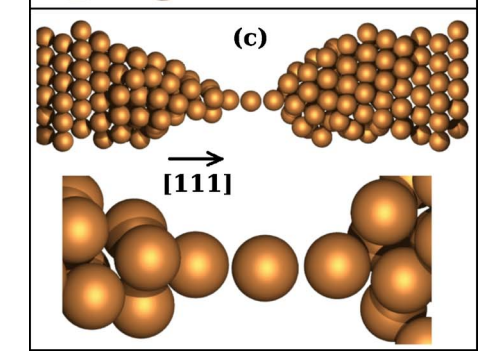
Sato, F; Moreira, AS; Bettini, J; Coura, PZ; Dantas, SO; Ugarte, D; Galvao, DS
Transmission electron microscopy and molecular dynamics study of the formation of suspended copper linear atomic chains Journal Article
Em: Physical Review-Section B-Condensed Matter, vol. 74, não 19, pp. 193401–193401, 2006.
Resumo | Links | BibTeX | Tags: Linear Atomic Chains, Metallic Nanowires, Molecular Dynamics, TEM
@article{sato2006surface,
title = {Transmission electron microscopy and molecular dynamics study of the formation of suspended copper linear atomic chains},
author = {Sato, F and Moreira, AS and Bettini, J and Coura, PZ and Dantas, SO and Ugarte, D and Galvao, DS},
url = {http://journals.aps.org/prb/abstract/10.1103/PhysRevB.74.193401},
year = {2006},
date = {2006-01-01},
journal = {Physical Review-Section B-Condensed Matter},
volume = {74},
number = {19},
pages = {193401--193401},
publisher = {Woodbury, NY: published by the American Physical Society through the American Institute of Physics, c1998-},
abstract = {We report high-resolution transmission electron microscopy and molecular dynamics simulation results of mechanically stretching nanowires leading to linear atomic suspended chain (LAC) formation. In contrast with some previous experimental and theoretical works in the literature that stated that the formation of LAC’s for copper should be unlikely our results showed the existence of LAC’s for the [111], [110], and [100] crystallographic directions, being thus the sequence of most probable occurrence. Our results clearly indicate that temperture and pulling velocity, associated with internal stress, are fundamental aspects to determine LAC formation.},
keywords = {Linear Atomic Chains, Metallic Nanowires, Molecular Dynamics, TEM},
pubstate = {published},
tppubtype = {article}
}
2005
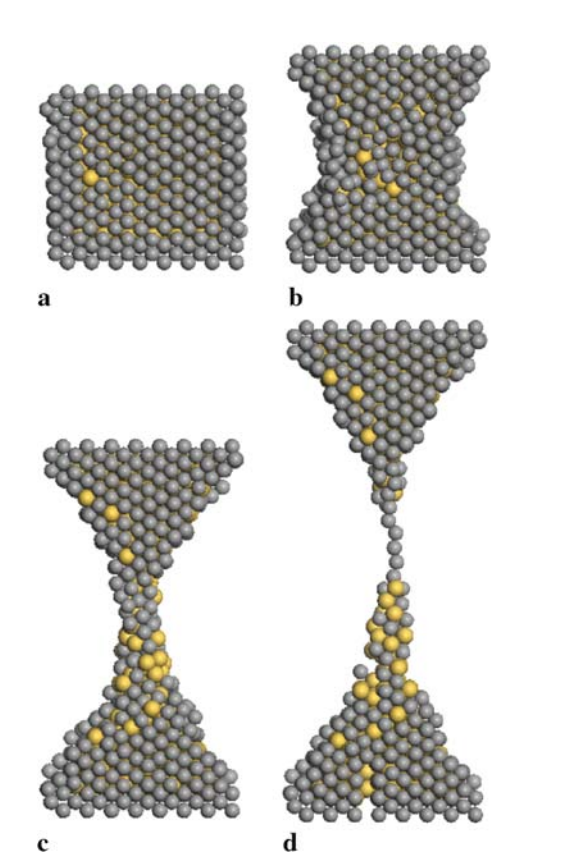
Sato, F; Moreira, AS; Coura, PZ; Dantas, SO; Legoas, SB; Ugarte, D; Galvao, DS
Computer simulations of gold nanowire formation: the role of outlayer atoms Journal Article
Em: Applied Physics A (invited paper), vol. 81, não 8, pp. 1527–1531, 2005.
Resumo | Links | BibTeX | Tags: Linear Atomic Chains, Metallic Nanowires, Molecular Dynamics, TEM
@article{sato2005computer,
title = {Computer simulations of gold nanowire formation: the role of outlayer atoms},
author = {Sato, F and Moreira, AS and Coura, PZ and Dantas, SO and Legoas, SB and Ugarte, D and Galvao, DS},
url = {http://link.springer.com/article/10.1007/s00339-005-3390-2},
year = {2005},
date = {2005-01-01},
journal = {Applied Physics A (invited paper)},
volume = {81},
number = {8},
pages = {1527--1531},
publisher = {Springer-Verlag},
abstract = {Metallic nanowires (NWs) have been the object of intense theoretical and experimental investigations in the last years. In this work we present and review a new methodology we developed to study NW formation from mechanical stretching. This methodology is based on tight-binding molecular dynamics techniques using second-moment approximations. This methodology had been proven to be very effective in the study of NWs, reliably reproducing the main experimentally observed structural features. We have also investigated the problem of determining from what regions the atoms composing the linear atomic chains come. Our results show that ∼90% of these atoms come from outmost external layers.
},
keywords = {Linear Atomic Chains, Metallic Nanowires, Molecular Dynamics, TEM},
pubstate = {published},
tppubtype = {article}
}
Legoas, SB; Rodrigues, V; Ugarte, D; Galvao, DS
Legoas et al. Reply Journal Article
Em: Physical Review Letters, vol. 95, não 16, pp. 169602, 2005.
Links | BibTeX | Tags: Linear Atomic Chains, Metallic Nanowires, Molecular Dynamics
@article{legoas2005legoas,
title = {Legoas et al. Reply},
author = {Legoas, SB and Rodrigues, V and Ugarte, D and Galvao, DS},
url = {http://journals.aps.org/prl/abstract/10.1103/PhysRevLett.95.169602},
year = {2005},
date = {2005-01-01},
journal = {Physical Review Letters},
volume = {95},
number = {16},
pages = {169602},
keywords = {Linear Atomic Chains, Metallic Nanowires, Molecular Dynamics},
pubstate = {published},
tppubtype = {article}
}
2004
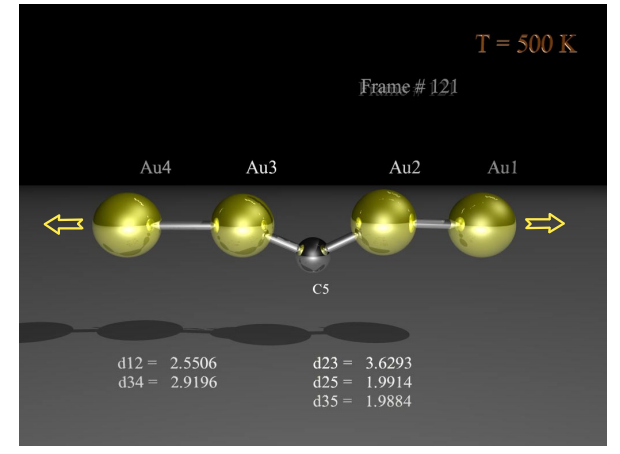
Legoas, Sergio B; Rodrigues, Varlei; Ugarte, Daniel; Galvao, Douglas S
Contaminants in suspended gold chains: An ab initio molecular dynamics study Journal Article
Em: Physical Review Letters, vol. 93, não 21, pp. 216103, 2004.
Resumo | Links | BibTeX | Tags: DFT, Electronic Structure, Linear Atomic Chains, Metallic Nanowires, top20
@article{legoas2004contaminants,
title = {Contaminants in suspended gold chains: An ab initio molecular dynamics study},
author = {Legoas, Sergio B and Rodrigues, Varlei and Ugarte, Daniel and Galvao, Douglas S},
url = {http://journals.aps.org/prl/abstract/10.1103/PhysRevLett.93.216103},
year = {2004},
date = {2004-01-01},
journal = {Physical Review Letters},
volume = {93},
number = {21},
pages = {216103},
publisher = {American Physical Society},
abstract = {Recently, we have proposed that the origin of anomalously long interatomic distances in suspended gold chains could be the result of carbon contamination during sample manipulation [S. B. Legoas et al., Phys. Rev. Lett. 88, 076105 (2002)]. More recently, however, other works have proposed that hydrogen instead of carbon should be the most probable contaminant. We report ab initio molecular dynamics results for different temperatures considering different possible contaminants. Our results show that at nonzero temperatures (more realistic to simulate the experimental conditions) hydrogen may be ruled out and carbon atoms remain the best candidate for contamination.},
keywords = {DFT, Electronic Structure, Linear Atomic Chains, Metallic Nanowires, top20},
pubstate = {published},
tppubtype = {article}
}
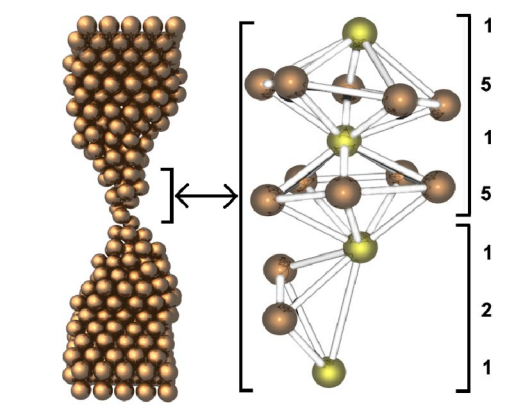
Gonzalez, JC; Rodrigues, V; Bettini, J; Rego, LGC; Rocha, AR; Coura, PZ; Dantas, SO; Sato, F; Galvao, DS; Ugarte, D
Indication of unusual pentagonal structures in atomic-size Cu nanowires Journal Article
Em: Physical Review Letters, vol. 93, não 12, pp. 126103, 2004.
Resumo | Links | BibTeX | Tags: Copper Nanowires, Linear Atomic Chains, Metallic Nanowires, Molecular Dynamics, TEM, top20
@article{gonzalez2004indication,
title = {Indication of unusual pentagonal structures in atomic-size Cu nanowires},
author = {Gonzalez, JC and Rodrigues, V and Bettini, J and Rego, LGC and Rocha, AR and Coura, PZ and Dantas, SO and Sato, F and Galvao, DS and Ugarte, D},
url = {http://journals.aps.org/prl/abstract/10.1103/PhysRevLett.93.126103},
year = {2004},
date = {2004-01-01},
journal = {Physical Review Letters},
volume = {93},
number = {12},
pages = {126103},
publisher = {APS},
abstract = {We present a study of the structural and quantum conductance properties of atomic-size copper nanowires generated by mechanical stretching. The atomistic evolution was derived from time-resolved electron microscopy observations and molecular dynamics simulations. We have analyzed the quantum transport behavior by means of conductance measurements and theoretical calculations. The results suggest the formation of an unusual and highly stable pentagonal Cu nanowire with a diameter of ∼0.45 nm and ∼4.5 conductance quanta.
},
keywords = {Copper Nanowires, Linear Atomic Chains, Metallic Nanowires, Molecular Dynamics, TEM, top20},
pubstate = {published},
tppubtype = {article}
}
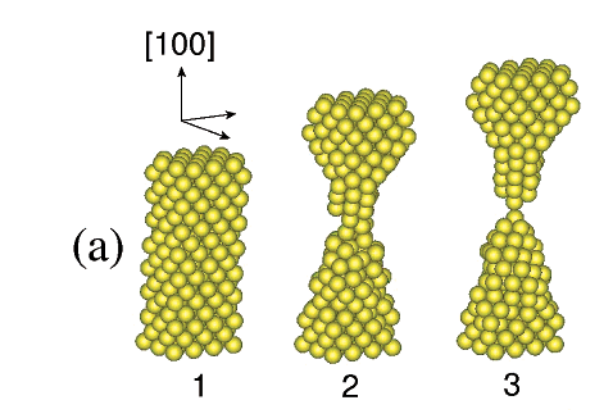
Coura, Pablo Z; Legoas, Sergio B; Moreira, Anderson S; Sato, Fernando; Rodrigues, Varlei; Dantas, Socrates O; Ugarte, Daniel; Galvao, Douglas S
On the structural and stability features of linear atomic suspended chains formed from gold nanowires stretching Journal Article
Em: Nano Letters, vol. 4, não 7, pp. 1187–1191, 2004.
Resumo | Links | BibTeX | Tags: Liinear Atomic Chains, Metallic Nanowires, Molecular Dynamics, Structure, TEM
@article{coura2004structural,
title = {On the structural and stability features of linear atomic suspended chains formed from gold nanowires stretching},
author = {Coura, Pablo Z and Legoas, Sergio B and Moreira, Anderson S and Sato, Fernando and Rodrigues, Varlei and Dantas, Socrates O and Ugarte, Daniel and Galvao, Douglas S},
url = {http://pubs.acs.org/doi/abs/10.1021/nl049725h},
year = {2004},
date = {2004-01-01},
journal = {Nano Letters},
volume = {4},
number = {7},
pages = {1187--1191},
publisher = {American Chemical Society},
abstract = {Metallic nanowires (NWs) have been intensily investigated in the past years, but details on
their formation are still not completely understood. In this work we report high resolution
transmission electron microscopy data and molecular dynamics simulation results for gold
NW elongation. Our results show that different initial crystallographic orientations lead to
very differentiated linear atomic suspended chain (LAC) formations and strongly support that
kinetic aspects are the dominant mechanisms determining the LAC morphologies.},
keywords = {Liinear Atomic Chains, Metallic Nanowires, Molecular Dynamics, Structure, TEM},
pubstate = {published},
tppubtype = {article}
}
their formation are still not completely understood. In this work we report high resolution
transmission electron microscopy data and molecular dynamics simulation results for gold
NW elongation. Our results show that different initial crystallographic orientations lead to
very differentiated linear atomic suspended chain (LAC) formations and strongly support that
kinetic aspects are the dominant mechanisms determining the LAC morphologies.
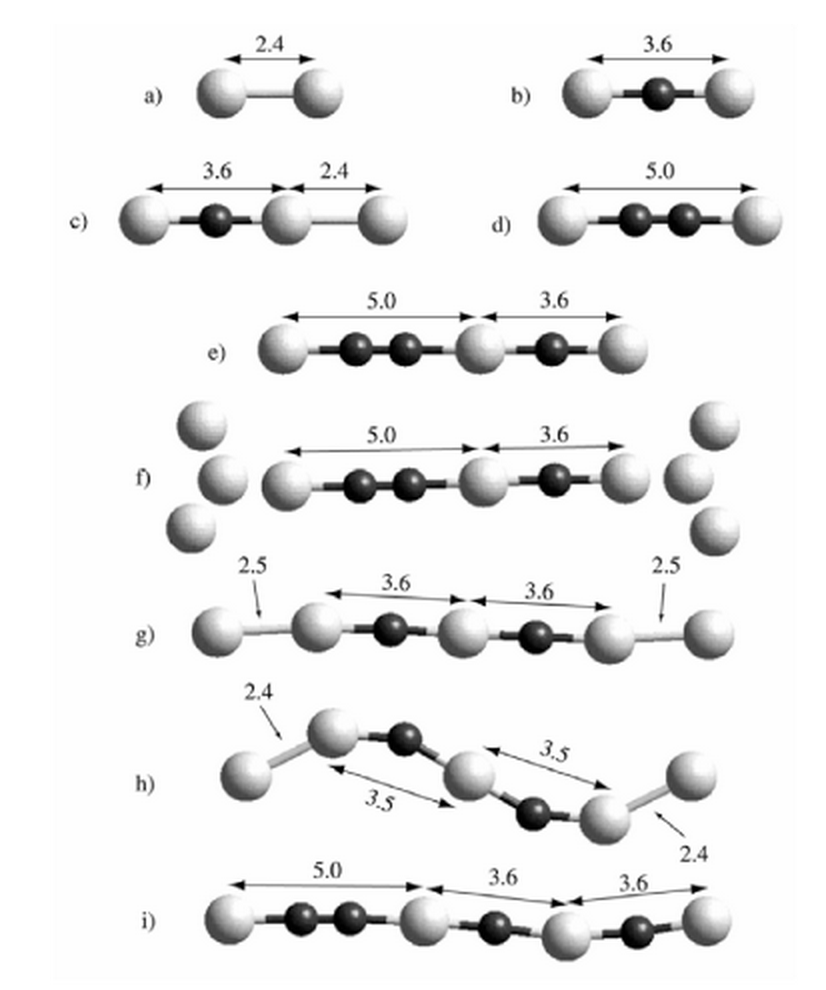
Galvao, Douglas Soares; Rodrigues, Varlei; Ugarte, Daniel; Legoas, Sergio Benites
The role of carbon contamination in metallic nanowires Journal Article
Em: Materials Research, vol. 7, não 2, pp. 339–342, 2004.
Resumo | Links | BibTeX | Tags: Contaminantes, Electronic Structure, Linear Atomic Chains, Metallic Nanowires, Structure
@article{galvao2004role,
title = {The role of carbon contamination in metallic nanowires},
author = {Galvao, Douglas Soares and Rodrigues, Varlei and Ugarte, Daniel and Legoas, Sergio Benites},
url = {http://www.scielo.br/scielo.php?pid=S1516-14392004000200020&script=sci_arttext},
year = {2004},
date = {2004-01-01},
journal = {Materials Research},
volume = {7},
number = {2},
pages = {339--342},
publisher = {SciELO Brasil},
abstract = {Metallic nanowires have attracted much attention in the last years due to new phenomena such as quantum conductance and the existence of unexpected long interatomic distances attaining 0.3-0.5 nm. These large distances represented a challenge for physical interpretation. In this work we present experimental data from high-resolution transmission electron microscopy and results from ab initio calculations for suspended gold chains and show that these large distances can be easily explained by the presence of carbon atoms as contaminants. In principle the present conclusions can be also applied to other metallic nanowires (such as Ag and Pt) whose structures also present large interatomic distances.},
keywords = {Contaminantes, Electronic Structure, Linear Atomic Chains, Metallic Nanowires, Structure},
pubstate = {published},
tppubtype = {article}
}
2002
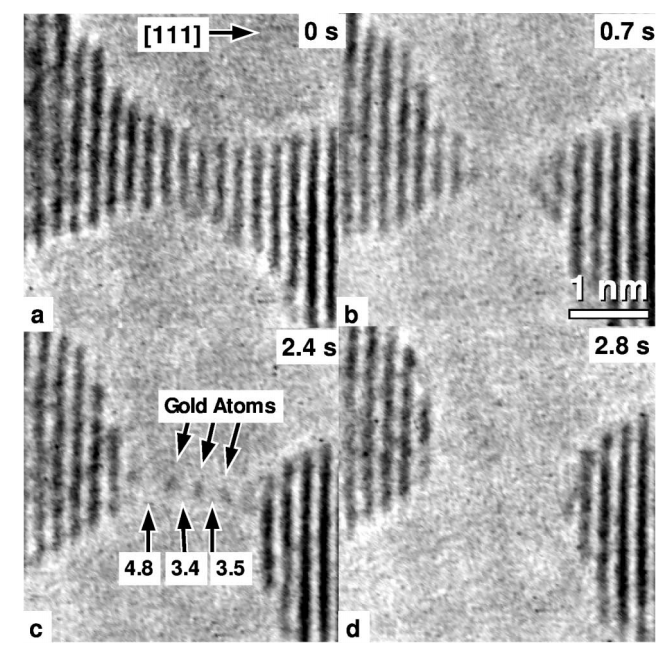
Legoas, Sergio B; Galvao, Douglas S; Rodrigues, Varlei; Ugarte, Daniel
Origin of anomalously long interatomic distances in suspended gold chains Journal Article
Em: Physical Review Letters, vol. 88, não 7, pp. 076105, 2002.
Resumo | Links | BibTeX | Tags: DFT, Electronic Structure, Linear Atomic Chains, Metallic Nanowires, TEM, top20
@article{legoas2002origin,
title = {Origin of anomalously long interatomic distances in suspended gold chains},
author = {Legoas, Sergio B and Galvao, Douglas S and Rodrigues, Varlei and Ugarte, Daniel},
url = {http://journals.aps.org/prl/abstract/10.1103/PhysRevLett.88.076105},
year = {2002},
date = {2002-01-01},
journal = {Physical Review Letters},
volume = {88},
number = {7},
pages = {076105},
publisher = {American Physical Society},
abstract = {The discovery of long bonds in gold atom chains has represented a challenge for physical interpretation. In fact, interatomic distances frequently attain 3.0–3.6 Å values, and distances as large as 5.0 Å may be occasionally observed. Here we studied gold chains by transmission electron microscopy and performed theoretical calculations using cluster ab initio density functional formalism. We show that the insertion of two carbon atoms is required to account for the longest bonds, while distances above 3 Å may be due to a mixture of clean and one C atom contaminated bonds.},
keywords = {DFT, Electronic Structure, Linear Atomic Chains, Metallic Nanowires, TEM, top20},
pubstate = {published},
tppubtype = {article}
}
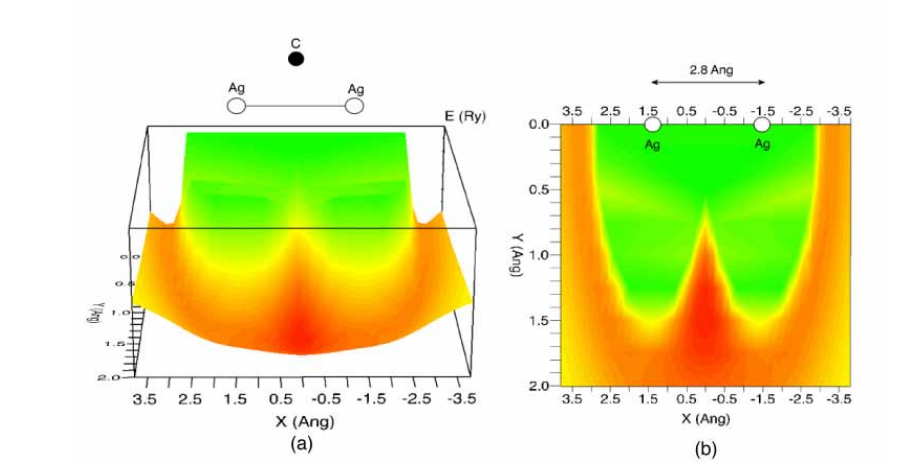
Legoas, Sergio B; Galvao, Douglas S; Rodrigues, Varlei; Ugarte, Daniel
The Role of Carbon Contamination in Suspended Gold Nanowires Journal Article
Em: MRS Proceedings, vol. 738, pp. G14–6, 2002.
Resumo | Links | BibTeX | Tags: DFT, Electronic Structure, Linear Atomic Chains, Metallic Nanowires, TEM
@article{legoas2002role,
title = {The Role of Carbon Contamination in Suspended Gold Nanowires},
author = {Legoas, Sergio B and Galvao, Douglas S and Rodrigues, Varlei and Ugarte, Daniel},
url = {http://journals.cambridge.org/action/displayAbstract?fromPage=online&aid=8031754&fileId=S1946427400148249},
year = {2002},
date = {2002-01-01},
journal = {MRS Proceedings},
volume = {738},
pages = {G14--6},
publisher = {Cambridge University Press},
abstract = {Metallic nanowires represent very interesting systems due to new phenomena such as quantum conductance and unexpected long interatomic distances attaining 0.3–0.5 nm. These large distances represent a challenge for physical interpretation. In this work we present experimental data from transmission electron microscopy and results from ab initio density functional calculations for suspended gold chains. We show that large distances as 0.5 nm can be easily explained by the presence of carbon atoms as contaminants, while distances ranging from 0.29 up to 0.36 nm might be explained as resulting of a mixture of clean stressed and contaminated linear chains.},
keywords = {DFT, Electronic Structure, Linear Atomic Chains, Metallic Nanowires, TEM},
pubstate = {published},
tppubtype = {article}
}


